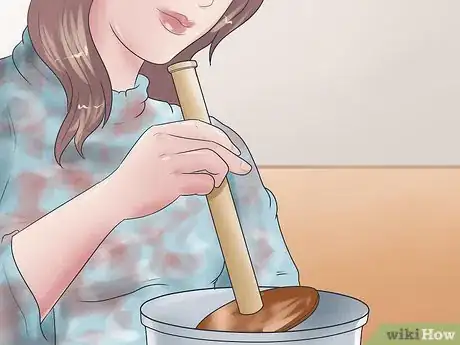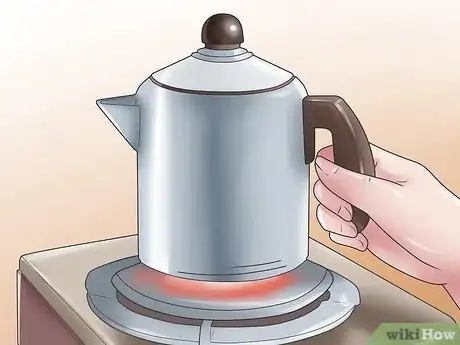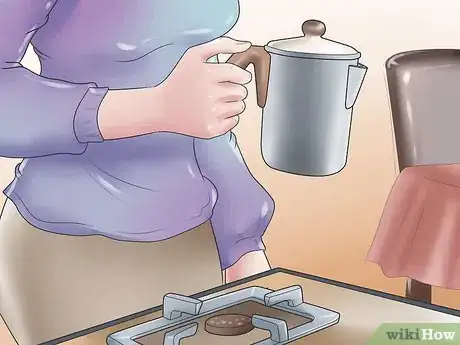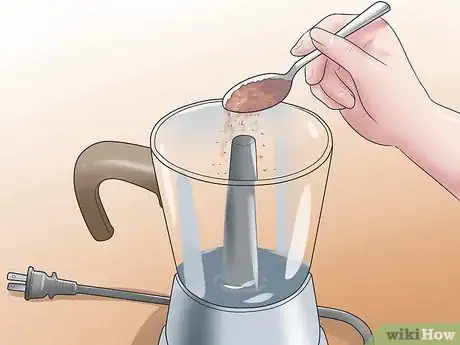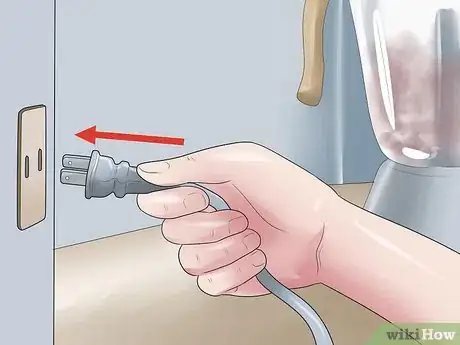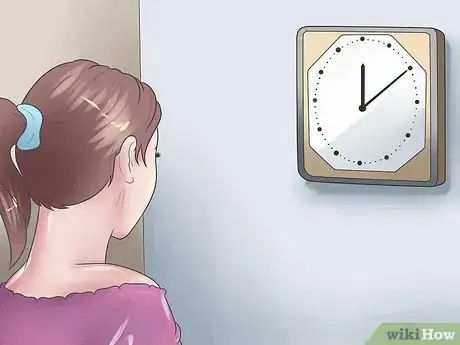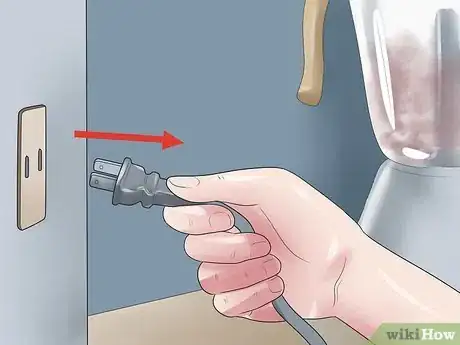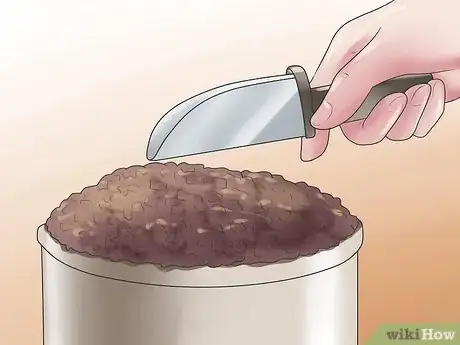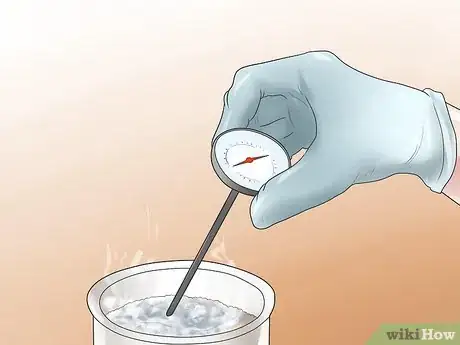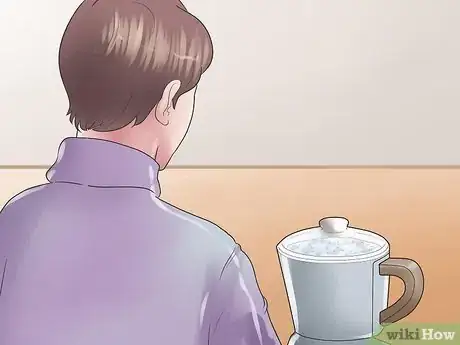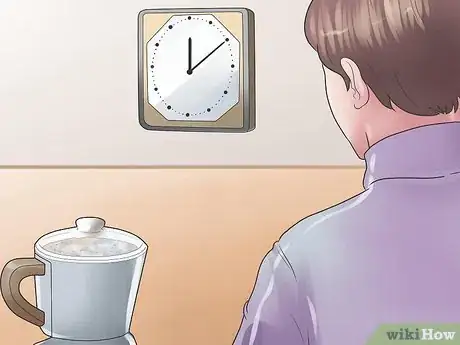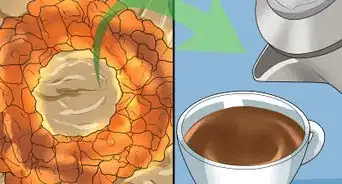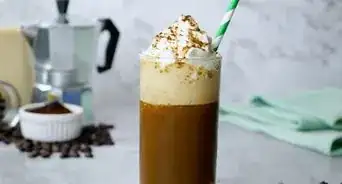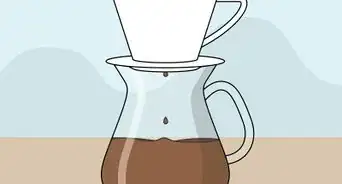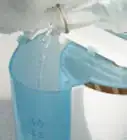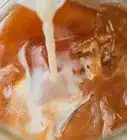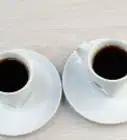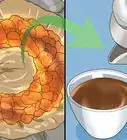wikiHow is a “wiki,” similar to Wikipedia, which means that many of our articles are co-written by multiple authors. To create this article, 33 people, some anonymous, worked to edit and improve it over time.
There are 12 references cited in this article, which can be found at the bottom of the page.
wikiHow marks an article as reader-approved once it receives enough positive feedback. This article received 15 testimonials and 96% of readers who voted found it helpful, earning it our reader-approved status.
This article has been viewed 481,062 times.
Learn more...
Whether you love the outdoors and you're looking for a way to have a steaming pot of coffee in the wilderness without access to fancy modern brewing technology or just looking for an easy, low-cost way to make your morning cup of joe, using a percolator can be a wise choice. Percolators are very simple to assemble and use — though some modern machines are powered by electricity, traditional percolators only need a heat source like a stove or a fire to produce coffee, making them a great choice for the hands-on, practical-minded coffee drinker. To learn how to percolate (or "perk") your coffee, get started with Step 1 below.
Steps
Stovetop Percolator
-
1Add water to the reservoir.[1] As with other forms of brewing coffee (like "drip" brewing methods), the first thing you'll need to do is decide how much coffee you want to brew, then add this amount of water to the "tank" or "reservoir" portion of the percolator. Depending on how your percolator is assembled, you may simply be able to open the lid and pour your water in, or you may need to remove the upper "basket", which holds the coffee grounds during brewing, to access the reservoir.
- Most standard-size percolators will hold about 4 - 8 cups, though differently-sized varieties exist. As a reference point, four cups of coffee equates to roughly two standard-sized mugfuls.
-
2Add the chamber and tube assembly. Next, if you had to remove the upper basket/chamber or the central tube to add the water, replace them now. Though every percolator is different, the basic construction of most is nearly identical — the coffee grounds should sit above the water in a small basket or chamber lined with small holes. A narrow tube should extend from this basket down into the water below.
- When the water heats, it will naturally move us the tube and into the coffee grounds. As it soaks into the grounds, it will pick up some of their aroma and flavor and drain back down into the water below, where the cycle will repeat.
Advertisement -
3Add ground coffee to the basket.[2] Next, add your coffee grounds to the upper basket lined with small holes. You can use either fresh-ground coffee or pre-ground beans — which ever you prefer.[3] Use roughly 1 tablespoon (15 ml) for each cup of water you use if you like your coffee strong.[4] For weaker coffee, use 1 teaspoon per cup. As you use your percolator, you may find that you need to adjust these measurements to get your coffee tasting just right.
- As we'll discuss below, for most percolator brewing, you'll want to use a light, low-acidity roast and a fairly coarse grind — coarser than what you might use for a standard drip machine.
-
4Place your percolator over a medium heat source. You're ready to go — now, all you need to do is heat up the water in the bottom of your percolator and physics will do the rest. Your goal is to heat up your water to the point that it's quite hot, but not boiling.[5] The hotter the water is, the more quickly it will absorb flavor from the beans, which means that boiling water can lead to coffee that's too strong. Use medium heat to get your water just below boiling, then reduce the heat to keep it hot, but not boiling or simmering. If you see steam at any point, your percolator is too hot and you should reduce your heat (or carefully move your percolator to a cooler area).
- In terms of heat sources, stove tops offer the most control, but you can also use campfires if you keep a careful eye on your coffee's progress.
- Always operate your percolator with medium heat from below — don't use an oven or another all-around heat source or you risk damaging your equipment and ruining your pot of coffee.
-
5Watch the glass globe to monitor your progress.[6] Many percolators contain a glass or see-through globe at the top to allow you to monitor the progress of your coffee as it brews. As the water begins to circulate through the percolator, you'll notice it sputter or bubble within this globe. The faster the sputtering, the hotter your water is, and the darker the water, the more "done" the coffee is. Ideally, once you reach a nice medium heat, you want to see bubbling every few seconds or so. This represents a good "pace" for percolating.
- Don't use percolators with plastic globes — coffee aficionados claim that exposing hot coffee to plastic can cause the taste of the plastic to transfer into the coffee, resulting in a foul-tasting brew.
-
6Allow your coffee to percolate for about ten minutes.[7] Depending on how strong you like your coffee and how hot you're heating your water, your percolator's ideal brewing time may differ. Note that brewing for ten minutes at the suggested medium pace will produce a pot of coffee that's fairly strong compared to an average pot of drip coffee. Obviously, for weaker coffee, you'll want to brew for less time, and for even stronger coffee, you'll want to brew for longer.[8]
- Using a kitchen timer to keep track of your coffee's progress can be a smart idea, but don't simply set your timer and come back when it goes off — if you do this, it's easy to over-heat your coffee and create a bitter, muddy product.
-
7Remove your percolator from the heat source.[9] When your coffee has finished percolating, carefully remove it from its heat source (use a towel or oven mitts to avoid burning yourself). Immediately open the percolator's lid and carefully remove the basket which contains the soaked coffee grounds. Discard the grounds (or recycle them). Don't leave the grounds in the percolator — if you do this, they can spill into your cup when you pour the coffee and may continue to make your coffee stronger by dripping into the coffee in the reservoir.
- After removing the basket with the grounds, your perked coffee is ready to serve. Enjoy your strong, old-fashioned style cup of joe!
Electric Percolator
-
1Add water and coffee as normal. Automatic electric percolators operate according to the same physical principals as stove top percolators, but they generally require less work and supervision on your part.[10] To begin, add your water and coffee as you normally would. Decide how much coffee you want, then add this amount of water to the bottom chamber. Remove the basket from the upper chamber and add your coffee grounds.
- The ratios for the amount of grounds you should use for your water is the same for electric percolators as it is for stove top percolators — use 1 tablespoon per cup of water for strong coffee and 1 teaspoon for weak coffee.
-
2Close the lid and plug your percolator in. Once your percolator is assembled and full of coffee and water, your work is basically done.[11] Connect the percolator's plug to a nearby outlet. Most percolators will begin to heat automatically, but if yours has an "on" button, you may need to hit this at this point. Your percolator's internal heating element should activate and begin to heat the water in the bottom chamber, causing it to cycle up the tube, through the coffee grounds, and back down into the reservoir as it would in a standard percolator.
-
3Wait about seven to ten minutes for the coffee to brew. All you need to do now is wait. Most electric percolators take about as long to finish brewing as stove top percolators — usually about seven to ten minutes. Many electric percolators will have an internal sensor that prevent them from heating the coffee past its optimal temperature, but if yours doesn't, you may need to watch the percolator as it brews. Otherwise, assuming there are no small children or pets in the area who may burn themselves on the hot machine, simply set a timer and let your percolator do the rest.
- Remember that if you ever see steam coming out of the percolator, it's brewing too hot. If you see this with an electric percolator, unplug immediately and allow it to cool for a minute or two before re-connecting it.
-
4Unplug immediately and remove grounds after percolating. When your timer goes off (or, if you have a percolator with an automatic timer, it shuts off automatically), unplug your percolator. Carefully open the lid and remove the upper basket containing the soaked coffee grounds. Discard these as you wish.
- At this point, you're done! Serve your coffee and enjoy!
Technique
-
1Choose a smooth, low-acidity coffee. As noted above, coffee that's brewed in a percolator can tend towards being somewhat strong, bitter, and "muddy". This is because, unlike many other brewing methods, percolating involves continuously recirculating water through the coffee grounds, rather than simply allowing it to drain through once. However, with a few simple tricks, it's possible to make coffee in a percolator that's not over-strong. For instance, starting with a coffee roast that's classified as being light, smooth, low-caffeine, and minimally acidic can help reduce the bitterness of percolated coffee. Though percolating will usually make your coffee stronger than it would otherwise be, starting with "mild" ingredients helps minimize this effect.
- If you're looking for weaker coffee, try buying a roast labelled "mild" or "smooth" from your favorite coffee brand (like Folgers, etc.) or opt for a "dark" roast — though these can be bitter, they have lower caffeine content and acidity than light roasts. If you have the money to spend, you might also want to try a mild specialty roast, like Oromo Yirgacheffe Ground Fair trade Coffee. Also, don't forget that you also always have the option to brew decaf!
-
2Use a coarse grind.[12] When it comes to coffee grounds, in general, the finer the beans are ground, the more quickly they'll transfer their flavor to the water and the stronger coffee they'll produce. Because of this, when you use a percolator to make coffee, you'll usually want to use a coarse grind. Coarse-ground beans will interact with the water less quickly, resulting in a final pot that's not quite as strong as it would otherwise be.
- If you have your own coffee grinder, try using its "coarse" setting. Otherwise, if you buy your coffee pre-ground, look for a "coarse" label on the packaging.
-
3Keep water temperature between 195 - 200o F (90.6 - 93.3o C).[13] When percolating, temperature is key — too cold and the water won't travel up the central tube, but too hot and you risk having an over-done cup of coffee that unappealingly strong. For optimal brewing, you'll usually want to keep your water between 195 - 200o F for the duration of the percolating process. This is just below the point that water begins to steam and boil (212o F (100o C)), but not so cold that the brewing process will be needlessly prolonged.
- Try using a kitchen thermometer to check the temperature of your water as your coffee percolates. For an accurate reading, try not to touch the thermometer to the hot metal sides of the pot — instead, carefully submerge it in the liquid.
-
4Allow to settle after brewing to eliminate cloudiness. Percolated coffee has a reputation for being somewhat cloudy or "muddy". Luckily, in most cases, this is easy to fix. Simply allow your coffee to sit for a few minutes after percolating. This gives the particles and sediment suspended in the water time to settle, resulting in a clearer cup of coffee.
- Note that doing this can produce a "puddle" of sediment at the bottom of your cup when you're done drinking. You may want to avoid drinking this, as some coffee drinkers find this to be bitter and unappetizing.
-
5Keep percolating time short. If you can't get your percolated coffee to taste better with any other method, simply reduce the amount of time that you allow it to percolate for. As noted throughout the article, percolating coffee can produce an unusually strong final product compared to other methods, so reducing the amount of time that you allow your coffee to brew can counteract this. Though most brewing instructions will recommend percolating for about seven to ten minutes, it's OK to brew for as short as four or five minutes if it results in coffee that you find more palatable.
- If you're unsure of how long to percolate your coffee, err on the short side, but be willing to experiment to find the perfect brewing length that's just right for you.
Community Q&A
-
QuestionIs there a brand of coffee that leans towards a sweeter, less bitter flavor?
 MicheleTop AnswererThere are many brands or rather roasts that do. You want a light breakfast roast, not a dark roast. The darker the roast, the more bitter. There are also many coffees that are pre-flavored, such as hazelnut or Irish cream. You can find most of the different flavors at specialty stores. You can, of course, always add milk and sweetener to reduce bitterness, or reduce the bitterness of the coffee by using less grounds for drip or perked coffee makers and/or not letting it steep as long in a French press. The longer coffee steeps and/or the higher the ratio of grounds to water, the richer and, for some, more bitter it will taste.
MicheleTop AnswererThere are many brands or rather roasts that do. You want a light breakfast roast, not a dark roast. The darker the roast, the more bitter. There are also many coffees that are pre-flavored, such as hazelnut or Irish cream. You can find most of the different flavors at specialty stores. You can, of course, always add milk and sweetener to reduce bitterness, or reduce the bitterness of the coffee by using less grounds for drip or perked coffee makers and/or not letting it steep as long in a French press. The longer coffee steeps and/or the higher the ratio of grounds to water, the richer and, for some, more bitter it will taste. -
QuestionDoes it quit perking when finished?
 Community AnswerNo. It'll keep perking as long as it's on the heat. That's why you have to time it to your taste preference.
Community AnswerNo. It'll keep perking as long as it's on the heat. That's why you have to time it to your taste preference. -
QuestionI have a percolator without a bubble on top; how do I know it's percolating?
 MicheleTop AnswererIf you don't have a see-through top, then you'll have to listen for the perk. You should hear the coffee "jumping" up and down. If you're using a stovetop percolator, start on medium to medium-high heat. Once you hear the water start to bubble up, reduce the heat to where you hear it "perk" every 2 - 3 seconds. Leave it like this for 5 - 10 minutes and your coffee should be ready.
MicheleTop AnswererIf you don't have a see-through top, then you'll have to listen for the perk. You should hear the coffee "jumping" up and down. If you're using a stovetop percolator, start on medium to medium-high heat. Once you hear the water start to bubble up, reduce the heat to where you hear it "perk" every 2 - 3 seconds. Leave it like this for 5 - 10 minutes and your coffee should be ready.
Warnings
- Do not start a percolator with hot water.⧼thumbs_response⧽
- As always when working with hot liquids, be careful.⧼thumbs_response⧽
- A good coffee maker will keep the temperature of the coffee between 190 and 200 degrees F throughout the percolation process. A percolator, unfortunately, tends to boil the coffee ruining the best of the flavors.⧼thumbs_response⧽
- Percolating coffee starts drawing color and flavor out of the coffee grounds from the first percolation. That's where the positives of percolating end. Percolating bubbles the water through the grounds continuously until the heating element shuts off.⧼thumbs_response⧽
Things You'll Need
- Percolator
- Coffee grounds
- Cool, clear water
- Heat source or electric outlet
- Mug
References
- ↑ https://www.roastycoffee.com/stovetop-percolator/
- ↑ https://www.roastycoffee.com/stovetop-percolator/
- ↑ https://www.homegrounds.co/how-to-grind-coffee-without-a-grinder/
- ↑ https://www.coffeedetective.com/stove-top-coffee-percolator.html
- ↑ https://www.roastycoffee.com/stovetop-percolator/
- ↑ https://www.roastycoffee.com/stovetop-percolator/
- ↑ https://www.roastycoffee.com/stovetop-percolator/
- ↑ https://www.myrecipes.com/extracrispy/how-to-make-coffee-in-a-percolator
- ↑ https://www.roastycoffee.com/stovetop-percolator/
- ↑ https://www.reviewed.com/home-outdoors/features/why-buy-an-electric-percolator
- ↑ https://www.talkaboutcoffee.com/how-to-make-coffee-in-a-percolator.html
- ↑ https://www.specialty-coffee-advisor.com/how-to-grind-coffee.html
- ↑ https://www.thekitchn.com/do-you-need-to-worry-about-water-temperature-when-brewing-coffee-smart-coffee-regular-joes-216229
- ↑ https://www.roastycoffee.com/coffee-sweeteners/
- http://www.coffeedetective.com/stove-top-coffee-percolator.html
- http://www.coffeesage.com/how-to-percolate-coffee/
- http://www.howtobrewcoffee.com/percolator.htm
About This Article
To perk coffee, begin by adding water to the reservoir of the percolator and ground coffee into the basket above it. Next, replace the lid and put the percolator on the stove over medium heat. If you see steam or if the water starts to boil, turn down the heat so that the coffee doesn’t get too strong. After the coffee has percolated for 10 minutes, remove it from the heat. Then, open the percolator’s lid and remove the basket with the coffee grounds before pouring yourself a cup of coffee. To learn about the best types of coffee to use in your percolator, read on!

